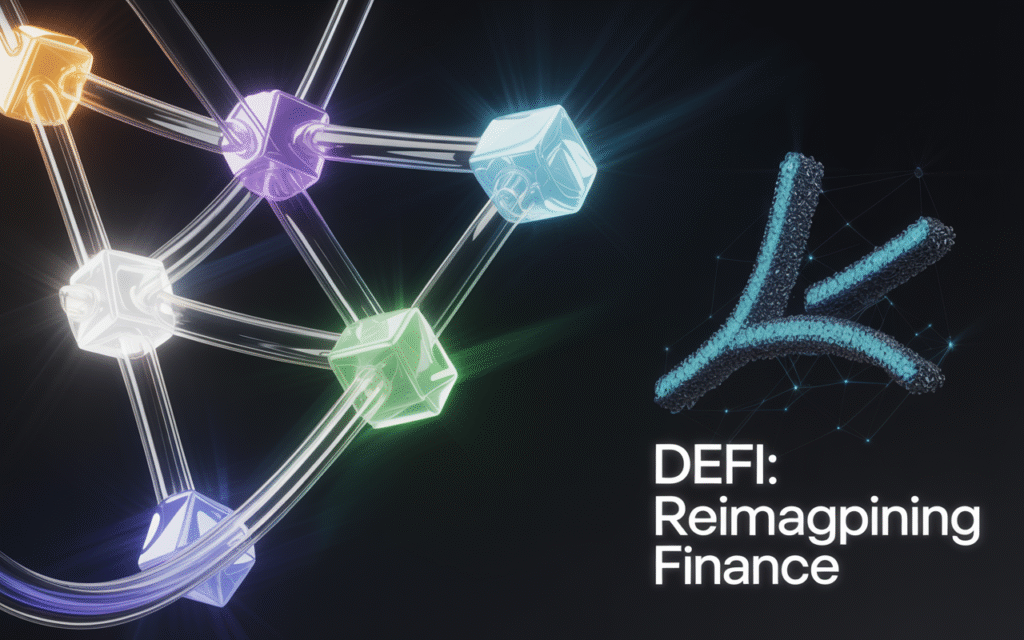
Alright, let’s be real for a second.
You’ve probably heard the word “DeFi” floating around Twitter or Reddit, maybe your coworker won’t shut up about “staking” and “yield farming,” and you’re sitting there thinking, “Okay, but what the heck is DeFi, and is it too late for me to get in?” Been there. It can feel like everyone’s already ahead, throwing terms around like they’re ordering coffee, while you’re still trying to figure out what ETH even is.
If you’re new to crypto or you’ve been saving a few dollars on Cash App and are now wondering, “What’s next?”, you’re in the right place. Let’s break down DeFi in plain, human English so you can actually understand what it is, why it matters, and how you can carefully start investing if you decide it’s for you.
So… What Is DeFi, Really?
DeFi stands for “Decentralized Finance.” I know, sounds fancy, but here’s the simplest way I can put it:
It’s like having a bank on your phone, but without the bank.
You can:
✅ Save and earn interest.
✅ Borrow money using your crypto as collateral.
✅ Lend your crypto and earn passive income.
✅ Trade crypto directly with others without a middleman.
And it’s all done using smart contracts on blockchains like Ethereum. No need for a banker in a suit telling you you need a credit check. DeFi puts the power back in your hands, which is cool, but also means you’re responsible if you mess up. No “forgot password” button, remember?
Why Should You Care About DeFi?
Let’s be honest, traditional banks can be slow, have fees for everything, and sometimes feel like they’re working against you. DeFi opens opportunities for:
✅ Better interest rates (sometimes way higher than a traditional savings account).
✅ Access for people who can’t get a traditional bank loan.
✅ Control over your money 24/7.
But, te lo digo por experiencia, DeFi is not a magic money machine. There’s risk, and you have to do your homework before jumping in.
Real-Life Example: Mike’s DeFi Adventure
Mike, a 28-year-old barista in Portland, started with crypto during COVID. He got into DeFi by staking some of his ETH on Aave and earning interest instead of letting it sit on Coinbase.
He started small, like $100, to see how it worked. He watched a ton of YouTube videos (Whiteboard Crypto, Coin Bureau) and joined Reddit groups to learn. After a few months, he was earning about 5% on his ETH, which for him felt way better than letting his money sit in a savings account earning basically nothing.
How Can You Start Investing in DeFi?
1. Learn Before You Leap
The truth is, the DeFi space is full of hype, scams, and complicated jargon. Before you throw your money in, learn how things work.
✅ Watch Whiteboard Crypto or Coin Bureau on YouTube.
✅ Read The Bitcoin Standard or Layered Money if you want broader context.
✅ Follow DeFi Pulse and DeFi Llama to track protocols.
2. Get a Crypto Wallet
To use DeFi, you need a wallet that connects to decentralized apps (dApps). MetaMask is the most popular for Ethereum-based DeFi. It’s a browser extension and mobile app.
Ojo con esto: When you set up your wallet, you’ll get a seed phrase (12-24 words). Write it down on paper (not your phone, not your email) and store it safely. If you lose it, your crypto is gone forever.
3. Choose a DeFi Platform Carefully
There are many platforms, but for starters:
✅ Aave: For lending and borrowing crypto safely.
✅ Uniswap: For swapping tokens directly with others.
✅ Compound: Another lending/borrowing platform.
Stick with well-known platforms with high liquidity and solid reputations.
4. Start Small
Don’t throw your rent money into DeFi. Seriously. Start with a small amount you can afford to lose, like $20-$50, just to learn how transactions work, how to connect your wallet, and how gas fees affect you.
5. Understand the Risks
DeFi can offer crazy interest rates, but they come with risks:
✅ Smart Contract Risks: Bugs can lead to loss of funds.
✅ Rug Pulls: Developers drain funds and disappear.
✅ High Volatility: Token values can swing wildly.
Take your time. Research. Don’t follow hype blindly.

DeFi Jargon You Might Hear (Simplified)
✅ Staking: Locking up your crypto to earn rewards.
✅ Liquidity Pool: Pooling your crypto with others to help trades happen, earning you fees.
✅ Yield Farming: Moving crypto between platforms to chase the highest returns.
✅ APR/APY: Interest rates you earn, usually higher than a bank but fluctuate.
Don’t worry about mastering all these right away. Learn as you go.
A Note on Taxes (Yeah, Uncle Sam Wants His Cut)
In the U.S., crypto transactions, including DeFi, are taxable. Apps like CoinTracker or Koinly can help track your transactions and simplify your taxes. Don’t ignore this—better to stay on top of it than deal with IRS headaches later.
Final Thoughts: Take Control, But Stay Smart
The truth is, DeFi is one of the most exciting parts of crypto because it gives power back to everyday people. You can earn, borrow, and lend without a middleman. But with that power comes responsibility.
You don’t need to go all in. Start small, learn, experiment, and see if it fits your financial goals. Don’t get swept up by TikTok videos promising “easy 100x gains.” DeFi can be a tool for financial growth, but it’s not a lottery ticket.
You’ve got this. If you ever need help, want to share your DeFi journey, or just want to rant about gas fees being ridiculous, shoot me a message or drop a comment. I’m here, rooting for you as you learn to take control of your money in this new digital world.
